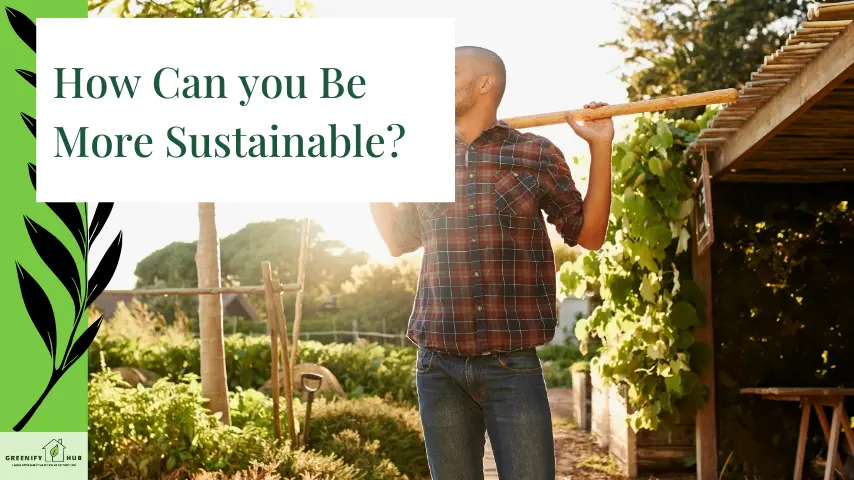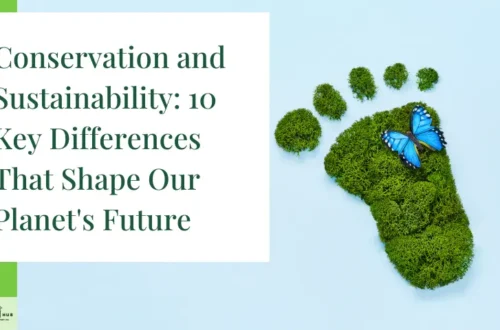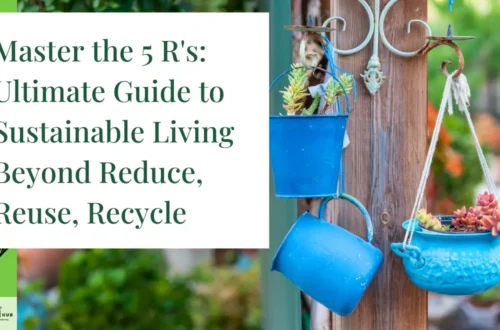How Can you Be More Sustainable?

Sustainable living is all about making conscious decisions that reduce our carbon footprint and protect the environment.
It’s like being a superhero for Earth, but instead of wearing a cape, you’re carrying a reusable shopping bag!
Climate change and global warming are real threats, and our greenhouse gas emissions are a big part of the problem. But here’s the good news: we can all be part of the solution.
Imagine if everyone in your neighborhood decided to use one less plastic bottle a day. That small change could make a huge difference!
Sustainable living isn’t just about saving the planet; it’s about creating a better future for ourselves and generations to come. It’s about finding that sweet spot where we meet our needs without compromising the ability of future generations to meet theirs.
Think of it as a balancing act between our wants and the Earth’s needs. It’s about making smarter choices in our everyday lives, from the food we eat to the way we travel.
Sustainable living is our powerful tool to combat climate change, reduce our carbon footprint, and create a healthier planet for future generations.
The Urgent Need for Sustainable Practices
Our planet is crying out for help. The Earth’s natural resources are being depleted at an alarming rate due to our ever-increasing level of human consumption.
It’s like we’re treating the Earth as an all-you-can-eat buffet, forgetting that once the food’s gone, it’s gone for good.
We’re facing a critical moment in history. The choices we make today will shape the world of tomorrow.
Imagine if we continue business as usual:
– Melting ice caps
– Rising sea levels
– More extreme weather events
Sounds like a disaster movie, right? But it doesn’t have to be our reality.
By adopting sustainable practices, we can turn the tide. It’s not just about saving polar bears (though that’s important too!); it’s about ensuring a livable planet for all of us.
The urgent need for sustainable practices stems from our overconsumption of natural resources, making immediate action crucial for our planet’s future.
Mindful Consumption: Rethinking Our Shopping Habits
Ever caught yourself buying something you don’t really need? We’ve all been there. It’s an unfortunate effect of capitalism that we’re constantly bombarded with ads telling us to buy more stuff.
But here’s a radical idea: what if we bought less stuff?
Mindful consumption is all about pausing before purchasing. It’s asking yourself:
– Do I really need this?
– Will it truly improve my life?
– Is there a more sustainable alternative?
Think of it as putting your wallet on a diet. Just as we watch what we eat for our health, we can watch what we buy for the planet’s health.
The power of individual action shouldn’t be underestimated. Every time you choose not to buy something unnecessary, you’re casting a vote for a more sustainable world.
Imagine if everyone in your city decided to buy one less new item each month. The reduction in resource use and waste would be enormous!
Choosing Secondhand and Sustainable Products
When you do need to buy something, consider secondhand options first. It’s like treasure hunting – you never know what gems you might find!
Buying secondhand:
– Supports your local economy
– Gives new life to existing items
– Reduces demand for new production
When buying new, look for sustainable, locally-made goods. It’s a great way to support your community and reduce transportation emissions.
Mindful consumption involves buying less, choosing secondhand options, and supporting sustainable, local goods to reduce our environmental impact.
Reducing Plastic Waste: A Step Towards a Cleaner Planet
Plastic is everywhere, from our kitchen drawers to our oceans. But here’s a sobering thought: every piece of plastic ever made still exists somewhere on our planet.
It’s time to embrace waste wisdom and say goodbye to single-use plastics.
Start with the low-hanging fruit:
– Ditch single-use water bottles for a reusable one
– Say no to plastic straws
– Bring your own bags for grocery shopping
Think of it as a plastic diet. Just as we might cut out junk food for our health, we can cut out unnecessary plastics for the planet’s health.
Imagine if everyone in your town replaced just one single-use plastic item with a reusable alternative. The reduction in plastic waste would be staggering!
Reducing plastic waste, especially single-use items, is a crucial step towards a cleaner planet and can be achieved through simple daily choices.
Adopting a Plant-Based Diet for Environmental Impact
Did you know that what’s on your plate can have a massive impact on the planet? Meat production is a major contributor to greenhouse gas emissions.
But don’t panic! You don’t need to go full vegan overnight. Even small changes can make a big difference.
Try these tasty ideas:
– Meatless Mondays
– Swapping beef for chicken or fish
– Exploring delicious plant-based recipes
Think of it as an adventure for your taste buds. You might discover new favorite foods you never knew existed!
Switching to more plant-based foods isn’t just good for the planet; it’s often healthier for you too. It’s a win-win!
Imagine if your whole family decided to have one plant-based meal a day. The reduction in environmental impact would be significant.
Adopting a more plant-based diet can significantly reduce your environmental impact while opening up a world of delicious new food options.
Simplifying Celebrations: Eco-Friendly Holiday Practices
Holidays are meant to be joyful, not wasteful. But often, our celebrations come with a hefty environmental price tag.
Here’s an effective step: simplify your celebrations.
Try these eco-friendly party ideas:
– Use reusable decorations
– Opt for digital invitations
– Serve food on real plates, not disposables
Think of it as a challenge to make your celebrations as close to zero waste as possible. It’s like playing a green party game!
Imagine if every holiday party in your neighborhood adopted just one eco-friendly practice. The collective reduction in waste would be impressive.
Simplifying celebrations with eco-friendly practices can significantly reduce waste while maintaining the joy and spirit of the occasion.
Choosing Organic: Supporting Sustainable Agriculture
Organic isn’t just a trendy label – it’s a way to support sustainable farming practices.
Conventional farming often uses the most toxic pesticides, spreading pounds of pesticide over crops.
But organic farming:
– Avoids synthetic pesticides
– Promotes soil health
– Supports biodiversity
Think of it as choosing food that’s good for you and the Earth. It’s like hitting two birds with one stone (but in a non-violent, eco-friendly way, of course!).
Imagine if your entire grocery store switched to organic produce. The reduction in harmful chemicals entering our environment would be enormous!
Choosing organic products supports sustainable agriculture, reduces pesticide use, and promotes a healthier environment for all.
Watch the video below to understand why sustainable farming matters, presented by Dean Carlson:
Sustainable Fashion: Breaking Free from Fast Fashion
Did you know the fashion industry is one of the most environmentally destructive industries in the world?
Fast fashion encourages us to buy more and more new garments, often worn only a few times before being discarded.
But we can break free from this cycle:
– Buy quality clothes that last
– Shop secondhand
– Support sustainable fashion brands
Think of your wardrobe as a carefully curated art collection, not a constantly changing fashion show.
Imagine if everyone in your city decided to buy just one less new clothing item this month. The reduction in resource use and waste would be significant!
Breaking free from fast fashion by choosing quality, secondhand, or sustainable options can significantly reduce the environmental impact of our clothing choices.
Water Conservation: Protecting Our Most Precious Resource
Water might seem abundant, but freshwater is actually a limited resource. We use massive amounts of water every day, often without realizing it.
Did you know it takes 25,000 gallons of water to raise one pound of beef? That’s enough to fill a small swimming pool!
Try these water-saving tips:
– Fix leaky faucets
– Take shorter showers
– Water your garden in the early morning or late evening
Think of water conservation as a game. How low can you get your water bill?
Imagine if every household in your city reduced their water use by just 10%. The amount of water saved could sustain entire ecosystems!
Water conservation is crucial for protecting our limited freshwater resources and can be achieved through simple daily habits and mindful consumption choices.
Green Transportation: Reducing Your Carbon Footprint
Our daily commutes and travel habits can have a big impact on our carbon footprint. But there are many ways to green up our transportation.
Consider these eco-friendly options:
– Use public transportation
– Try a car-free day once a week
– Join a bike share program
– Support the transition to electric vehicle fleets
Think of it as an adventure. How many different ways can you find to get from point A to point B?
Embracing Alternative Transportation Methods
Moving away from fossil fuel-dependent transport can significantly reduce greenhouse gas emissions.
Try these fun alternatives:
– Bike to work (great exercise too!)
– Carpool with colleagues (social hour on wheels!)
– Walk for short trips (free steps for your fitness tracker!)
Imagine if everyone in your office decided to use alternative transportation just one day a week. The reduction in emissions would be substantial!
Embracing green transportation options and alternative methods can significantly reduce our carbon footprint while offering health benefits and new experiences.
Creating an Energy-Efficient Home
Our homes are like energy-hungry monsters, constantly gobbling up electricity. But with a few tweaks, we can put them on an energy diet.
Try these energy-saving tips:
– Switch to LED bulbs
– Use a programmable thermostat
– Unplug devices when not in use
Some companies are leading the way in energy efficiency. For example, Godrej Properties, a real estate company in India, is pioneering sustainable building practices.
Think of your home as a mini power plant. How much energy can you generate or save?
Imagine if every home in your neighborhood implemented just one energy-saving measure. The collective reduction in energy use would be impressive!
Creating an energy-efficient home through simple changes and smart technology can significantly reduce energy consumption and inspire sustainable practices in the real estate industry.
Wildlife Protection: Making Conscious Consumer Choices
Our everyday choices can have a big impact on wild animals, sometimes pushing species onto the endangered species list.
For instance, the demand for bluefin tuna has led to severe overfishing. That’s why some people participate in a “bluefin boycott”.
Here are some wildlife-friendly choices:
– Avoid products made from endangered animals
– Choose sustainable seafood options
– Support wildlife conservation organizations
Think of it as being a superhero for animals. Your choices can help protect species around the world!
Imagine if everyone in your country decided to avoid just one product harmful to wildlife. The positive impact on endangered species could be life-changing!
Making conscious consumer choices that prioritize wildlife protection can significantly contribute to the conservation of endangered species and ecosystems.
Family Planning and Its Environmental Impact
As the human population shoots up, so does our impact on the planet. But this is a sensitive topic that involves personal choices and reproductive health.
The key is education and access to resources. When people have information and options, they can make informed decisions about family size.
Consider these facts:
– A smaller family generally has a lower environmental impact
– Education often leads to smaller family sizes
– Access to reproductive health services is crucial
Think of it as planning for the future – not just your family’s future, but the planet’s too.
Imagine if every country provided comprehensive sex education and access to reproductive health services. The potential for stabilizing population growth could be enormous!
Family planning, supported by education and access to reproductive health services, can play a significant role in managing population growth and its environmental impact.
Political Engagement for a Sustainable Future
Your vote and voice matter more than you might think! Engaging with local officials and supporting environmentally conscious candidates can drive significant change.
Here’s how you can get involved:
– Attend town hall meetings
– Write to your representatives
– Support environmental initiatives
In the United States and around the world, grassroots movements have led to major environmental policies.
Think of political engagement as your superpower. You have the ability to shape policies that affect millions!
Imagine if everyone in your voting district prioritized environmental issues. The collective impact could lead to groundbreaking sustainable policies!
Political engagement, from local to national levels, is crucial for creating policies that support a sustainable future and amplify the collective impact of individual actions.
Sustainable Urban Living: Making the Most of Small Spaces
Living in a city doesn’t mean you can’t be eco-friendly. In fact, urban living can be very sustainable when done right!
Here are some ideas for sustainable city living:
– Create a balcony garden
– Use vertical space for plants
– Join a community garden
Did you know? Cities actually use less of the Earth’s surface per person than suburban or rural areas.
Think of your small urban space as a sustainability laboratory. How much green living can you pack into each square meter?
Imagine if every apartment in your building had a mini garden. The collective green space could significantly improve air quality and biodiversity!
Sustainable urban living maximizes limited space to create green environments, contributing to more efficient land use and improved city ecosystems.
The Power of Community in Sustainable Living
Remember, you’re not alone in this journey towards sustainability. Your best friends, neighbors, and community can be powerful allies.
Here are ways to engage your community:
– Start a neighborhood composting program
– Organize a community clean-up day
– Share eco-friendly tips on social media
Every effort counts, and when we work together, the impact multiplies!
Think of your community as a sustainability team. How can you work together to score points for the planet?
Imagine if every community in your city started one sustainable initiative. The collective impact would be truly transformative!
Harnessing the power of community in sustainable living can amplify individual efforts, creating a more significant and lasting impact on our environment.
Looking Ahead: Innovations for a Greener Future
The future of sustainability is exciting! Innovations are constantly emerging to help us live greener lives.
Some promising developments include:
– Lab-grown meat to reduce animal farming
– Advanced recycling technologies
– Renewable energy breakthroughs
Even solutions for major issues like melting Antarctic glaciers are being researched!
Think of these innovations as tools in our sustainability toolkit. The more tools we have, the better equipped we are to tackle environmental challenges.
Imagine a future where every home is energy-neutral, every product is recyclable, and our lifestyles are in harmony with nature. With continued innovation and commitment, this sustainable future is within our reach!
Ongoing innovations in sustainability offer hope and practical solutions for a greener future, making it increasingly feasible to live in harmony with our planet.
Conclusion
Embracing sustainable living is not just a trend; it’s a powerful way to transform your life and contribute to a greener future. By implementing the strategies outlined in this article, you can make a significant impact on reducing your carbon footprint and preserving our planet’s precious resources. From mindful consumption and adopting a plant-based diet to supporting sustainable fashion and engaging in political action, every step counts towards creating a more sustainable world.
Remember, the journey towards sustainable living is ongoing and evolving. As you incorporate these practices into your daily life, you’ll not only reduce your environmental impact but also experience a sense of fulfillment and connection to the world around you. Your individual efforts, combined with those of others, can create a ripple effect of positive change.
So, why wait? Start your sustainable living journey today and be part of the solution to our planet’s most pressing environmental challenges. Together, we can build a more sustainable, resilient, and harmonious future for generations to come.





